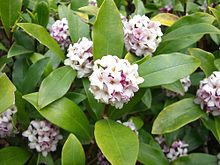
Salvia rosmarinus, commonly known as rosemary, is a shrub with fragrant, evergreen, needle-like leaves and white, pink, purple, or blue flowers, native to the Mediterranean region. Until 2017, it was known by the scientific name Rosmarinus officinalis, now a synonym.

Wisteria is a genus of flowering plants in the legume family, Fabaceae (Leguminosae). The genus includes four species of woody twining vines that are native to China, Japan, Korea, Vietnam, southern Canada, the Eastern United States, and north of Iran. They were later introduced to France, Germany and various other countries in Europe. Some species are popular ornamental plants. The genus name is also used as the English name, and may then be spelt 'wistaria'. In some countries in Western and Central Europe, Wisteria is also known by a variant spelling of the genus in which species were formerly placed, Glycine. Examples include the French glycines, the German Glyzinie, and the Polish glicynia.

Rosa rugosa is a species of rose native to eastern Asia, in northeastern China, Japan, Korea and southeastern Siberia, where it grows on beach coasts, often on sand dunes. It should not be confused with Rosa multiflora, which is also known as "Japanese rose". The Latin word "rugosa" means "wrinkled", referring to the wrinkled leaves. Often used as an ornamental plant, it has become invasive in parts of Europe, North America and South America.

Dianthus is a genus of about 340 species of flowering plants in the family Caryophyllaceae, native mainly to Europe and Asia, with a few species in north Africa and in southern Africa, and one species in arctic North America. Common names include carnation, pink and sweet william.

Hibiscus syriacus is a species of flowering plant in the mallow family, Malvaceae. It is native to areas of east Asia, but widely introduced elsewhere, including much of Europe and North America. It was given the epithet syriacus because it had been collected from gardens in Syria. Common names include the rose of Sharon,, Syrian ketmia, shrub althea (or simply althea), and rose mallow. It is the national flower of South Korea and is mentioned in the South Korean national anthem.

Daphne is a genus of between 70 and 95 species of deciduous and evergreen shrubs in the family Thymelaeaceae, native to Asia, Europe and north Africa. They are noted for their scented flowers and often brightly coloured berries. Two species are used to make paper. Many species are grown in gardens as ornamental plants; the smaller species are often used in rock gardens. All parts of daphnes are poisonous, especially the berries.
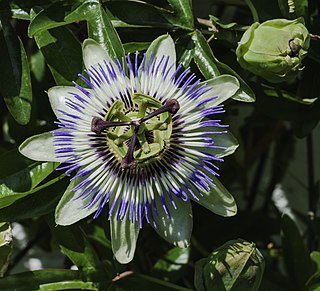
Passiflora caerulea, the blue passionflower, bluecrown passionflower or common passion flower, is a species of flowering plant native to South America. It has been introduced elsewhere. It is a vigorous, deciduous or semi-evergreen tendril vine growing to 10 m (33 ft) or more. Its leaves are palmate, and its fragrant flowers are blue-white with a prominent fringe of coronal filaments in bands of blue, white, yellow, and brown. The ovoid orange fruit, growing to 6 cm (2 in), is edible, but is variously described as having a bland, undesirable, or insipid taste. In South America, the plant is known for its medicinal properties, and is used by both the Toba and the Maka peoples.

Lavandula angustifolia, formerly L. officinalis, is a flowering plant in the family Lamiaceae, native to the Mediterranean. Its common names include lavender, true lavender and English lavender ; also garden lavender, common lavender and narrow-leaved lavender.

Jasminum polyanthum, the many-flowered jasmine, pink jasmine, or white jasmine, is a species of flowering plant in the olive family Oleaceae, native to China and Myanmar. A strong evergreen twining climber, it is especially noted for its abundant, highly fragrant pink to white flowers.

Filipendula rubra, also known as queen-of-the-prairie, is a species of flowering plant in the family Rosaceae native to the northeastern and central United States and southeastern Canada. It prefers full sun or partial shade and moist soil, but tolerates drier soil in a shadier location. It grows tall and firm, and produces blooms that are tiny and pink above its ferny, pointy leaves.

Plumeria rubra is a deciduous plant species belonging to the genus Plumeria. Originally native to Mexico, Central America, Colombia and Venezuela, it has been widely cultivated in subtropical and tropical climates worldwide and is a popular garden and park plant, as well as being used in temples and cemeteries. It grows as a spreading tree to 7–8 m (23–26 ft) high and wide, and is flushed with fragrant flowers of shades of pink, white and yellow over the summer and autumn.

Daphne bholua, the Nepalese paper plant, is a species of flowering shrub in the genus Daphne of the family Thymelaeaceae. It grows at altitudes of 1,700–3,500 m (5,577–11,483 ft) in the Himalayas and neighbouring mountain ranges, from Nepal to southern China. At lower altitudes it is found as an evergreen in thickets and forest margins; at higher altitudes, it is deciduous and is usually found in pastures and grassy glades. It usually reaches a height of about 2.5 m, though some specimens reach 4 m (13 ft) or more.

Garden roses are predominantly hybrid roses that are grown as ornamental plants in private or public gardens. They are one of the most popular and widely cultivated groups of flowering plants, especially in temperate climates. An enormous number of garden cultivars have been produced, especially over the last two centuries, though roses have been known in the garden for millennia beforehand. While most garden roses are grown for their flowers, often in dedicated rose gardens, some are also valued for other reasons, such as having ornamental fruit, providing ground cover, or for hedging.
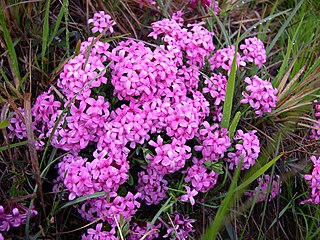
Daphne cneorum, the garland flower or rose daphne, is a species of flowering plant in the family Thymelaeaceae, commonly found in various pine forests across Europe. It is a prostrate spreading evergreen shrub to 20 cm (8 in), grown for its dense clusters of highly fragrant pink flowers in spring. All parts of the plant are poisonous to humans. Two common diseases are known as daphne sudden death syndrome and daphne virus X.

Campanula punctata, the spotted bellflower, is a species of flowering plant in the bellflower family Campanulaceae. This ornamental herbaceous perennial is native to Japan, Korea, China and Siberia, and is widely cultivated for its attractive bell-shaped flowers.
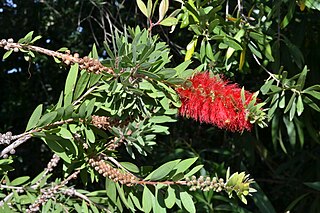
Melaleuca citrina, the common red bottlebrush, crimson bottlebrush, or lemon bottlebrush, is a plant in the myrtle family Myrtaceae, and is endemic to eastern Australia. Some Australian state herbaria continue to use the name Callistemon citrinus. It is a hardy and adaptable species, common in its natural habitat. It is widely cultivated, not only in Australia. It was one of the first Australian plants to be grown outside the country, having been taken to England in 1770 by Joseph Banks. Its showy red flower spikes, present over most of the year in an ideal situation, account for its popularity.

Daphne tangutica, syn. Daphne retusa, is a species of flowering plant in the family Thymelaeaceae, native to Tibet, China, and possibly Taiwan. It is an evergreen shrub growing to 1 m tall and wide, with leathery leaves and clusters of fragrant white and pink flowers in spring. The flowers are often followed by red berries. It grows in forests.
Thelymitra odora is a rare species of orchid in the family Orchidaceae and is endemic to a small area of South Australia. It has a single erect, channelled, linear leaf and up to four deep blue flowers. It is similar to T. pauciflora but is distinguished from that species by its slaty grey flower buds and a different lobe on top of the anther.
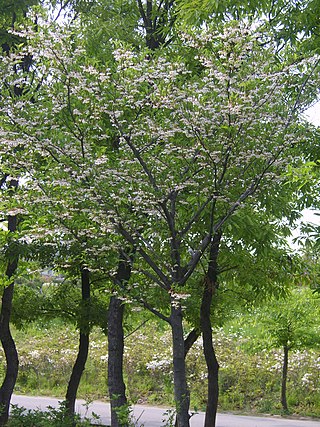
Styrax japonicus, also known as the Japanese snowbell, is a species of flowering plant in the family Styracaceae, native to Korea, Japan, and Southern China. Growing to 12 m (39 ft) tall by 8 m (26 ft) broad, it is a graceful, spreading deciduous tree with oval, upward-facing leaves which occasionally turn yellow or orange before falling in autumn. Masses of slightly fragrant, bell-shaped white flowers hang from the branches in summer, followed by fruits (drupes) which resemble olives in both shape and colour.

Streptoglossa odora is a species of flowering plant in the family Asteraceae. It is a spreading, perennial herb with pink or bluish-purple flowers. It grows in Queensland, Western Australia and the Northern Territory.
